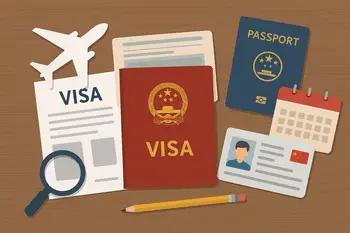
In recent years, China has emerged as a significant destination for global talent, with the number of foreigners living in mainland China increasing by nearly 50% in the last decade to approximately 846,000 according to the 2020 national census.
As China continues to reform its permanent residence policies, understanding how to effectively integrate into Chinese society has become essential for those seeking long-term success in the country.
Understanding the Importance of Integration
Integration isn’t just about personal comfort—it’s a formal requirement for permanent residence approval.
According to recent data from the National Immigration Administration, “insufficient integration into Chinese society” ranks among the top reasons for permanent residence application denials, with officials specifically citing:
- Limited Chinese language proficiency
- Minimal understanding of Chinese culture and customs
- Limited community involvement
- Lack of established social connections in China
Research published in the International Journal of Environmental Research and Public Health confirms that “the level of subjective social integration is largely influenced by local networks,” while “objective social integration depends largely on local and hometown networks” (PMC, 2022).
Regional Integration Considerations
Integration experiences vary significantly across China’s diverse regions.
The table below highlights key differences to consider:
| Region | Language Considerations | Cultural Characteristics | Integration Difficulty | Digital Adoption |
|---|---|---|---|---|
| Tier-1 Cities (Beijing, Shanghai, etc.) | English widely spoken, Mandarin essential | More international, faster pace | Moderate | Very high |
| Eastern Coastal Cities | Local dialects important, Mandarin essential | Blend of traditional and modern | Moderate to high | High |
| Western Cities (Xi’an, Chengdu) | Limited English, Mandarin crucial | More traditional, strong regional identity | High | Moderate to high |
| Rural Areas | Very limited English, local dialects dominant | Highly traditional | Very high | Moderate |
Essential Integration Strategies
1. Language Acquisition with Realistic Goals
Language remains the foundation of meaningful integration.
According to the 2025 China Expat Integration Survey by IkkyInChina, 78% of successful permanent residents achieved at least HSK 4 proficiency.
Practical approach:
- Set proficiency goals based on your region and profession
- Combine formal classes with immersive practice
- Use AI-assisted learning tools like HelloChinese or Duolingo
- Consider dialect basics if living outside major cities
- Join language exchange groups through InterNations
2. Digital Integration
In 2025 China, digital integration is as important as cultural integration.
The Chinese digital ecosystem is essential for daily life, professional networking, and social connections.
Essential platforms:
- WeChat (communication, payments, services)
- Alipay (financial transactions)
- Xiaohongshu/RED (social recommendations)
- Zhihu (knowledge sharing)
- Meituan (food delivery, local services)
Most platforms offer English interfaces, but navigating Chinese-only features is often necessary.
Consider joining digital integration workshops offered by organizations like China Expat Society.
3. Building Meaningful Local Networks
Research from Xi’an Jiaotong University demonstrates that local networks significantly impact both subjective and objective integration (PMC, 2022).
Successful integration requires connections beyond the expat bubble.
Network building strategies:
- Join community activities in your neighborhood
- Participate in cultural events and festivals
- Volunteer with local organizations
- Attend professional networking events
- Consider mentorship programs that pair foreigners with local guides
4. Understanding Workplace Culture
Chinese workplace culture differs significantly from Western environments.
According to the 2025 China Business Culture Report, understanding these differences is crucial for professional integration.
Key workplace considerations:
- Hierarchy and respect for authority
- Indirect communication styles
- Importance of “face” (mianzi)
- Group harmony over individual expression
- Building relationships before business (guanxi)
Organizations like the China-Britain Business Council and American Chamber of Commerce in China offer cultural integration workshops specifically for professional settings.
5. Navigating Housing and Community
Housing choices significantly impact integration experiences.
The 2025 Expat Housing Survey by SJ Grand found that foreigners living in mixed Chinese-international communities reported 40% higher integration satisfaction than those in expat-dominated areas.
Housing considerations:
- Mixed communities offer better integration opportunities
- Consider proximity to both expat and local amenities
- Research neighborhood demographics before committing
- Understand local regulations affecting foreign residents
6. Identity Negotiation and Cultural Balance
Integration doesn’t mean abandoning your cultural identity. Successful permanent residents develop a bicultural approach that respects Chinese norms while maintaining their core identity.
Balancing strategies:
- Identify which aspects of Chinese culture align with your values
- Find communities that celebrate your home culture
- Create traditions that blend both cultures
- Develop comfort with cultural code-switching
Overcoming Common Integration Barriers
Even with permanent residence status, integration challenges persist.
Recent research from IkkyInChina identifies these common barriers and potential solutions:
| Barrier | Description | Potential Solutions |
|---|---|---|
| Implicit Bias | Subtle discrimination in professional or social settings | Build strong professional credentials, develop cultural fluency, find allies |
| Service Limitations | Restricted access to certain services or platforms | Use VPNs when necessary, find local workarounds, join expat forums for advice |
| Cultural Isolation | Feeling disconnected despite physical presence | Join cross-cultural groups, find cultural bridges, maintain connection with home while building local ties |
| Language Plateau | Reaching intermediate level but struggling to advance | Find language partners, consume native media, join specialized language groups |
Resources for Integration Support
Government Resources
- National Immigration Administration – Official information on residence policies
- Local Foreign Affairs Offices – Integration programs and support
- Community centers in expat-heavy districts
Community Organizations
- InterNations China – Expat networking and support
- Expatica China – Resources and guides for foreigners
- Regional expat associations (search for your city)
Digital Resources
- WeChat groups for expats in your region
- China Expat Society – Integration workshops and resources
- That’s Magazines – Local events and community information
Conclusion
Successful integration into Chinese society as a permanent resident requires intentional effort across multiple dimensions—linguistic, cultural, professional, digital, and social.
By approaching integration as an ongoing process rather than a destination, permanent residents can build fulfilling lives that honor both their heritage and their new home.
The most successfully integrated permanent residents maintain a growth mindset, viewing integration challenges as opportunities to develop new perspectives and skills.
As China continues to evolve its approach to foreign talent, those who invest in meaningful integration will find themselves well-positioned to contribute to and benefit from China’s dynamic society.


